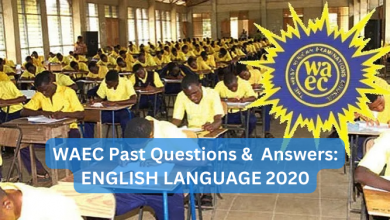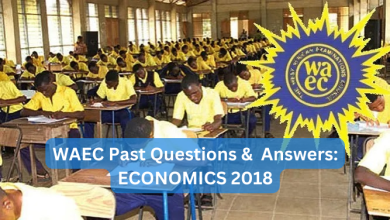WAEC Past Questions & Answers: BIOLOGY 2018
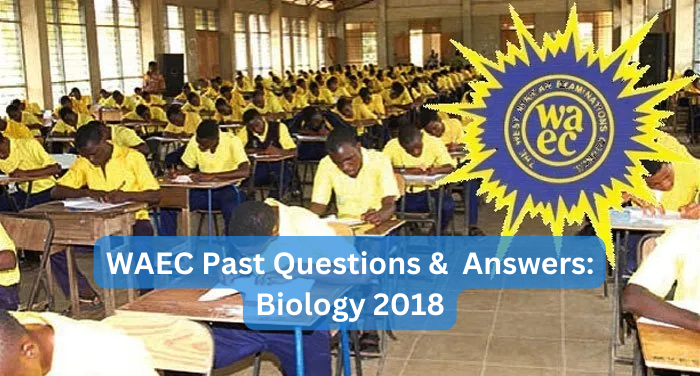
Welcome to our WAEC past question and answer series. In this post, we will be sharing ‘recent’ past questions and their answers for various subjects. Stay tuned enjoy while learning.
1. A group of closely related organisms capable of interbreeding to produce the fertile offspring are known as members of a…
(A) Kingdom
(B) class
(C) family
(D) species
2. A beaker of pond water containing few specimens of Euglena was placed in a dark room for two weeks. At the end of this period, the specimens of Euglena were still alive because they were
(A) able to carry out holozoic nutrition
(B) able to carry out photosynthesis using carbon dioxide in the pond water
(C) better adapted to life in darkness than to life in light
(D) not overcrowded
3. The cytoplasm of a cell is considered a very important component because it
(A) regulates the amount of energy in the cell
(B) suspends all cell organelles
(C) is the outermost part of the cell
(D) is solely responsible for cell division
4.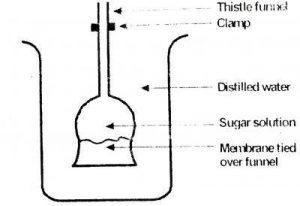
Use the diagram shown to answer the question. After an hour, the level of water in the thistle funnel will
(A) rise
(B) fall
(C) remain the same
(D) double
5.
Use the diagram shown to answer the question. The experiment above is used to demonstrate the process of
(A) transportation
(B) water culture
(C) diffusion
(D) osmosis
6.
Use the diagram shown to answer the question. In plant cells, the role of the membrane is played by the
(A) nucleolus
(B) cell wall
(C) cytoplasm
(D) mitochondrion
7.Red blood cells were found to have burst open after being placed in distill for an hour. This phenomenon is known as
(A) plasmolysis
(B) diffusion
(C) haemolysis
(D) wilting
8. The curvature movement of plants in response to the stimulus of water is called
(A) hydrotropism
(B) geotropism
(C) Phototropism
(D) thigmotropism
9. The overall reaction in glycolysis can be summarised as
(A) CHO —–> CHO + 4H + ATP
(B) CHO —–> 2CHO + 4H + 2ATP
(C) CHO —–> 2CHO + 4H + ADP
(D) CHO —–> 2CHO + 4H + 2ADP
10. The longest bone in the body is the
(A) humerous
(B) femur
(C) scapula
(D) tibia
11. Which of the following structures is not a skeletal material?
(A) Chitin
(B) Cartilage
(C) Bone
(D) Muscle
12. The reason why the flow of blood through the capillaries is very slow is
(A) because the walls of Capillaries are very thin
(B) to avoid high blood pressure
(C) to ensure that the individual does not get dizzy
(D) to allow adequate time for exchange of materials
13. Which of the following groups of organisms has kidney as the excretory organ?
(A) Fishes, amphibians, birds, man
(B) Fishes, amphibians, annelids, insects
(C) Fishes, reptiles, birds, tapeworm
(D) Fishes, protozoans, amphibians, man
14. Which of the following features is not a characteristic of arteries? Arteries
(A) possess valves at internals throughout their length
(B) have thick muscular and elastic walls
(C) carry blood away from the heart
(D) transport oxygenated blood with the exception of the pulmonary artery
15. 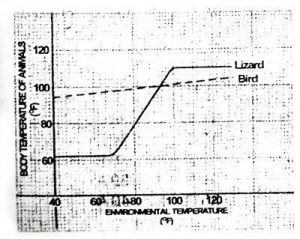
The graph above shows the results of a laboratory investigation which measured the body temperatures of a lizard and a bird under changing artificial conditions. Use it to answer the question.
Which of the statements below is valid?
(A) The bird’s blood was always warmer than that of the lizard
(B) The body temperature of the bird varied less than that of the lizard during changes in environmental temperature
(C) The body temperature of the bird remained constant despite changes in environmental temperature
(D) The body temperature of the lizard was always close to that of the environmental temperature
16. 
The graph below shows the results of a laboratory investigation which measured the body temperatures of a lizard and a bird under changing artificial conditions. Use it to answer the question.
What physiological term can used to describe the regulation of the body temperature of the of the Lizard?
(A) Homeostasis
(B) Homoithermy
(C) Poikilothermy
(D) Osmoregulation
17. The reason why hospitals use saline solutions as drip Instead of water is
(A) because salt is a preservative
(B) to prevent contamination of the body
(C) to maintain the composition of body fluids
(D) to increase the number of blood cells
18. The part of the ear which contains nerve cells sensitive to sound vibrations is the
(A) cochlea
(B) ampulla
(C) tympanum
(D) malleus
19. Spectacles with convex lenses correct long-sightedness by
(A) converging the light rays before they enter the eye
(B) diverging the light rays before they enter the eye
(C) reducing the light intensity before it enters the eye
(D) increasing the light intensity before it enters the eye
20.A seed of a flowering plant can best be described as
(A) radicle and plumule
(B) the developed ovule
(C) the embryo and endosperm
(D) developed ovary
21. Which of the following processes removes carbon from the atmosphere?
(A) putrefaction
(B) photosynthesis
(C) volcanic eruption
(D) burning of fuels
22. Which of the following cycles involves the process of precipitation and transpiration?
(A) water cycles
(B) carbon cycle
(C) nitrogen cycle
(D) oxygen cycle
23. What is the critical limiting factor for plants below the photic zone in an aquatic ecosystem?
(A) availability of nutrients
(B) availability of water
(C) intensity of light
(D) carbon dioxide concentration
24. Which of the following instruments is used to estimate the number of plants in a habitat?
(A) pooter
(B) pitfall trap
(C) quadrant
(D) sweep net
25. Which of the following statements is true about sandy soil?
(A) has limited air space
(B) is light and easy to dig
(C) drains slowly
(D) is heavy and poorly aerated
26. Which of the following organisms is a primary consumer?
(A) dog
(B) sheep
(C) grass
(D) fungus
27. Study the diagram of a food chain shown and use; it to answer the question.
P —> Q —> R —> S —> T
The organism designated P in the food chain above is normally sustained by energy from
(A) sunlight
(B) carbohydrates
(C) green plants
(D) mineral salts
28. Study the diagram of a food chain shown and use; it to answer the question.
P —> Q —> R —> S —> T
Which of the following statements best describes the organism designated R? It
(A) feeds on S
(B) is a primary consumer
(C) is a producer as well as a consumer
(D) is a secondary consumer
29. Which of the following diseases is not hereditary?
(A) Albinism
(B) Scabies
(C) Haemophilia
(DP) Colour blindness
30. The immediate product of meiosis in flowering plants is the
(A) sporophyte
(B) gametophyte
(C) zygote
(D) pollen grains
31. DNA in eukaryotic cells is contained in the
(A) central vacuole
(B) nucleus
(C) lysosome
(D) Golgi body
32. A man who is heterozygous for the disease haemophilia marries a woman who is double recessive for haemophilia. What percentage of their offspring would have the disease?
(A) 0%
(B) 25%
(C) 50%
(D) 75%
33.Cytokinesis of mitosis is a process that ensures that
(A) each daughter cell gets the necessary organelles
(B) there is distribution of a complete set of genes into each daughter cell
(C) daughter cell inherit new genetic combinations
(D) worn out organelles are excluded from daughter cells
34. An animal which is active during the day is known as a
(A) nocturnal animal
(B) diurnal animal
(C) terrestrial animal
(D) homortacmic animal
35. Evidence of evolution include the following except
(A) fossil records
(B) comparative anatomy
(C) mutation of genes
(D) geographical distribution of organisms
36. 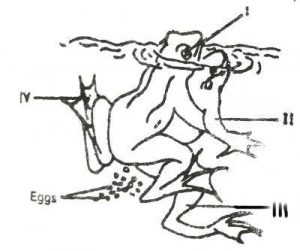
Use the diagram to answer the question. The diagram shows that the organisms are
(A) hermaphrodite
(B) viviparous
(C) oviparous
(D) ovoviviparous
37.
Use the diagram to answer the question. The breeding posture illustrated in the diagram is knows as
(A) mating
(B) amplexus
(C) courtship display
(D) reproductive swimming
38. An accurate identification of a rapist can be carried out by conducting
(A) RNA analysis
(B) DNA analysis
(C) blood group test
(D) behavioural tests
39. A boy who is fond of swimming in a pond finds himself passing urine with traces of blood. He is like to have contracted?
(A) schistosomiasis
(B) onchocerciasis
(C) poliomyelitis
(D) salmonellosis
40. The flippers of a whale and the fins of a fish are examples of
(A) divergent evolution
(B) co-evolution
(C) continuous variation
(D) convergent evolution
41. What it the function of contractile vacuole in paramecium
(A) Produces Enzymes
(B) Gets rid of excreta
(C) Stores and digest food
(D) Gets rid of excess water
42. The yellowish coloured liquid component of blood that normally holds the blood cells in suspension is
(A) serum
(B) plasma
(C) water
(D) thrombocyte
43. The function of pith in plant is
(A) Absorb mineral salt and nutrient from the soil
(B) Pith, or medulla, is a tissue in the stems of vascular plants. Pith is composed of soft, spongy parenchyma cells, which store and transport nutrients throughout the plant.
(C) trap chlorophyll from the sunlight
(D) Removal of waste product from the plant
44. A pollutant that is mostly associated with acid rain is
(A) Nitrogen (IV) oxide
(B) Ozone
(C) Fluorine
(D) Carbon (IV) oxide
45. What it the function of contractile vacuole in paramecium
(A) Produces Enzymes
(B) Gets rid of excreta
(C) Stores and digest food
(D) Gets rid of excess water
46. What it the function of contractile vacuole in paramecium
(A) Produces Enzymes
(B) Gets rid of excreta
(C) Stores and digest food
(D) Gets rid of excess water
47. How many days does is used for incubation of an egg to release chick
(A) 21
(B) 22
(C) 20
(D) 23
48. The four classes of cnidarian include the following except
(A) Turbellaria
(B) Anthozoa
(C) Scyphozoa
(D) cubozoa
49. 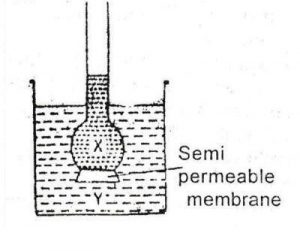
What would happen if solution Y is more concentrated than solution X in the diagram above
(A) The level of X would rise, Y would falls
(B) A. The level of X would rise, Y would rise
(C) The level of X and Y stands the same
(D) The level of Y would rise, X would fall.
50. Physiological adaptation to very dry conditions in animal demonstrates
(A) Xeromorphism
(B) Hibernation
(C) Aestivation
(D) Rejuvenation
51. The hormones secreted by pancreas serves to
(A) Facilitate the development of facial hairs
(B) Raise the level of calcium in the blood
(C) Lower blood glucose level
(D) Make the body react to emergencies
52. Blood circulation in a mammal is said to be double because
(A) It passes twice through the heart in a complete circuit
(B) It moves in both arteries and veins
(C) It circulates in both the hands and other organs
(D) The heart contains auricles and ventricles
53. Examples of animals with mammary glands include the following except
(A) Cow
(B) Goat
(C) Pig
(D) Hen
54. The hygrometer is used for measuring
(A) Relative Humidity
(B) Specific Gravity
(C) Rainfall
(D) Salinity
55. Mineral salts can be absorbed into roots by
(A) Osmosis only
(B) Osmosis and diffusion
(C) Diffusion and active transport
(D) Imbition only
56. Which is an Animal without red blood cells
(A) Frog
(B) Earthworm
(C) Snake
(D) Peacock
57. The temporary union of two organisms and the exchange of micro-nuclear elements is called
(A) Conjugation
(B) Binary fusion
(C) Extrapolation
(D) Interexchange
58. A plant tissue that carries water and mineral salt is
(A) Xylem
(B) Cortex
(C) Phloem
(D) Cambium
59. Which of the following relationship involves only one organism
(A) Saprophytism
(B) Commensalism
(C) Parasitism
(D) Symbiosis
60. The function of pith in plant is
(A) Absorb mineral salt and nutrient from the soil
(B) Pith, or medulla, is a tissue in the stems of vascular plants. Pith is composed of soft, spongy parenchyma cells, which store and transport nutrients throughout the plant.
(C) trap chlorophyll from the sunlight
(D) Removal of waste product from the plant
ANSWERS TO QUESTIONS
1. D
2. A
3. B
4. A
5. D
6. B
7. C
8. A
9. B
10. B
11. D
12. D
13. A
14. A
15. C
16. C
17. C
18. A
19. A
20. B
21. B
22. A
23. C
24. C
25. B
26. B
27. A
28. D
29. B
30. D
31. B
32. C
33. B
34. B
35. C
36. C
37. A
38. B
39. A
40. D
41. B
42. B
43. C
44. A
45. B
46. D
47. A
48. A
49. A
50. B
51. C
52. A
53. D
54. A
55. C
56. B
57. A
58. A
59. A
60. C



